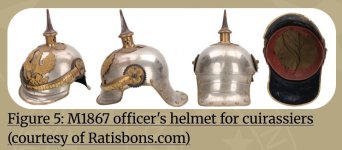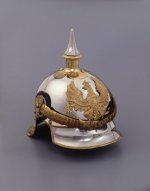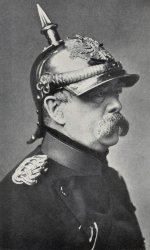I believe he was an adopted member of the 2nd kurassier regiment. Von Moltke called him something like “the civilian that wears a kurassier uniform”
Some information about Bismarck:
Bismarck began his military career on March 25, 1838 at the age of 23 as a one-year volunteer with the “Garde-Jägerbataillon” in Potsdam. In the same year he was transferred to the 2nd Jäger Division in Greifswald and was discharged on March 26, 1839 as a non-commissioned officer in the 1st Battalion of the 2nd Landwehr Regiment.
He was promoted to second lieutenant on August 12, 1841 and transferred to the battalion's cavalry on August 14 of that year.
On 13.4.1850 he transferred to the 2nd Battalion of the 26th Landwehr Regiment and on 29.4.1852 to the 7th Heavy Landwehr Cavalry Regiment (7. Schwere Landwehr-Reiter-Regiment). On 19.11.1854 he was promoted to Premier-Leutnant, and on 28.10.1859 to Rittmeister.
On 18.10.1861 he received the rank of major and on 20.9.1866, bypassing lieutenant colonel and colonel, the rank of Generalmajor. At the same time, he was appointed as head of the 7th Heavy Landwehr Cavalry Regiment.
On October 18, 1868, after the dissolution of the cavalry regiments, he became head of the 1st Magdeburg Landwehr Regiment No. 26 and at the same time he was placed à la suite with Cuirassier Regiment No. 7. This also gave him permission to wear the uniform at court and otherwise as he wished.
On the day of the imperial proclamation, January 18, 1871, he was promoted to General-Lieutenant and awarded the Iron Cross 1st and 2nd Class. On March 21, 1871, he was also elevated to the rank of prince by the count.
On March 22, 1876, on the occasion of the Emperor's birthday, he was promoted to General of Cavalry.
On September 1, 1884, he was finally awarded the highest military decoration “Pour le Mérite”, with oak leaves, although this was otherwise only awarded for repeated decorations of the order.
On March 8, 1888, Bismarck was able to shake hands with Emperor Wilhelm I for the last time. HRH wanted to see him again on his deathbed to express his deepest appreciation and gratitude. When the Emperor died on March 9, Bismarck tearfully announced the accession of Emperor Frederick III, which shows how much Emperor William I and Prince von Bismarck appreciated each other.
When the provincial Landwehr regiments were abolished, Prince von Bismarck, whose position with the 26th Landwehr Regiment was also affected, was placed à la suite with the 2nd Guards Landwehr Regiment on August 16, 1888.
On March 20, 1890, he was appointed “Generaloberst” of cavalry, with the rank of “Generalfeldmarschall”.
On January 26, 1894, he was appointed Chief of Cuirassier Regiment No. 7, leaving à la suite the 2nd Guards Landwehr Regiment.
Bismarck himself regarded all these promotions merely as titles. And he mainly wore his general's coat because he didn't have to change his clothes if he was summoned to the Emperor.









